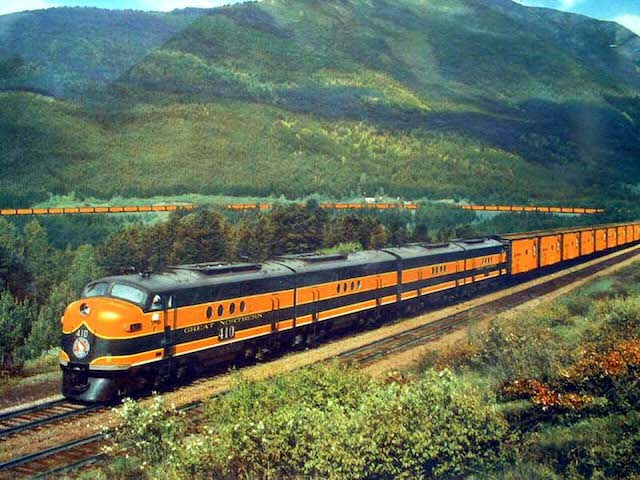I’ve previously written about the technologies that made streamliners possible, including Diesels, metallurgy, and air conditioning. One other technology worth mentioning is the paint or, more specifically, the lacquers that gave most streamliners their bright colors and brand identities. Even most stainless steel streamliners, except those of the Burlington and the Flying Yankee, were led by locomotives painted in bright colors.

Click image for a larger view.
In 1909, Henry Ford famously announced that any Model T buyer “can have a car painted any color that he wants so long as it is black.” His decision to use just one color was part of his quest to make his cars as affordable as possible. Within a few years, Ford was making more than half the cars sold in America.

Click image to download a PDF of this postcard.
As color historian Regina Lee Blaszczyk notes in an article on the color revolution, other auto manufacturers tried to differentiate themselves from Ford by offering other colors. But the enamel colors of the day tended to fade, chip, and scratch (which was another reason why Ford liked black). This is probably also why Pullman adopted dark browns and greens for its cars; before Pullman, many passenger cars had been painted yellow, but they no doubt faded and got dirty.

Orange and green are known as “Empire Builder” colors, but the colors were first applied by GM to these freight locomotives in 1940. Click image for a larger view.
As it happens, after World War I, the Dupont chemical company had used some of its profits from making explosives during the war to buy a 38 percent interest in General Motors. Working with GM, Dupont developed a lacquer with the brand name of Duco that was durable, didn’t fade, and could be applied quickly by spraying instead of brushing. Introduced in 1923, Duco was soon available in a thousand different colors and was in high demand among auto buyers and found its way into many other industries and consumer products as well. This led to the color revolution that is documented in Blaszczyk’s book of that name.

UP’s yellow streamliners were an homage to the yellow paint commonly used on passenger cars before Pullman painted all of its cars brownish-green. Click image to download a PDF of this postcard.
Naturally, when GM made its first Diesel locomotives in 1935, it painted them with Duco. Pullman and other passenger car manufacturers that weren’t leaving bare stainless steel followed suit. Without Duco and similar lacquers from other paint manufacturers, Union Pacific’s streamliners might not have been bright yellow, Great Northern’s Empire Builder might not have been orange and green, Atlantic Coast Line’s Champion might not have been purple, and Santa Fe’s warbonnets might not have been red.
